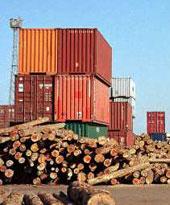
The slowdown in the growth rate may continue for the rest of the fiscal as the developed countries may go for fiscal consolidation by partially rolling back the economic stimulus packages, commerce secretary Rahul Khullar told reporters.
The rollback would contract demand in the developed markets, which are the mainstay of India's exports, he added.
In any case, the growth rate has started falling as it is now being calculated on a higher base of 2009-10, after the shipments started improving on signs of the global economic recovery.
"(Despite) all the hoopla about 30-35 per cent (export growth), the reality is 13.2 per cent (in July). Basically what is happening (is) that the base effect is wiped out," Khullar said.
Due to the low base effect, India's exports showed robust rate in April (36.2 per cent), May (35.1 per cent) and June (30.4 per cent).
Khullar further said that in the second half of 2010-11, exports would shrink due to aggregate demand contraction overseas and roll back of stimulus in the developed world.
"There is going to be a slowdown in the world in the next six months. . . that would translate into contraction in aggregate demand of our exports," he added.
The secretary asked the exporters to remain prepared for slowdown in their dispatches in the coming months.
However, Khullar said India would be able to meet the export target of $200 billion this fiscal. Exports in the last fiscal totalled $182 billion.
"We are on the track. Even if we post a 14-15 per cent growth for the remaining period of the year, we will reach $200 billion," he added.
Due to the global demand slump, the country's exports started contracting in October 2008 and entered into positive territory after 13 months in November last year.
Overseas shipments in April-July this fiscal aggregated $68.63 billion, up 30.1 per cent over the same period last year.
The exports sectors which performed badly in July 2010 include leather, electronics, man-made fibre, readymade garments, tea, rice and handicrafts.
India's apex exporters body FIEO said that the government should give more incentives to the laggard sectors in the Foreign Trade Policy review, scheduled for 23 August.
"The government should bring sector specific packages for sectors like apparel, leather and tea, which are not exhibiting growth," Federation of Indian Export Organisations president A Sakthivel said.
Meanwhile, imports in July rose by 34.3 per cent to $29.17 billion, taking the trade gap for the month to $12.93 billion.
Imports during the April-July period this fiscal were at $112 billion, up 33.3 per cent over the year-ago period.
The trade gap during the first four months of this fiscal is $43.6 billion.
Oil imports during the month stood at $7.6 billion and during April-July period, the imports grew by 4 per cent to $33 billion.
Giving details of the performance of exporting sectors which performed badly in July, Khullar said that handicrafts contracted by 60 per cent, rice by 45 per cent, tea by 25 per cent, ready made garments by 23 per cent and electronics products by 20.8 per cent.
Exports of rice, tobacco, ready made garments, handicrafts and electronics have also contracted during April-July period of this fiscal.
Due to the Eurozone crisis, the shipments of readymade garments and electronic products are contracting, Khullar said.
The main sectors that registered positive imports growth in July includes gold, machinery, iron and steel, gems and jewellery, chemicals, fertilisers, pharmaceuticals, he added.
While chemical imports grew by 100 per cent in July over the year ago period, iron and steel and gems and jewellery imports went up by 60 per cent and 70 per cent, respectively.
During April-July period, imports of gems and jewellery went up by 90 per cent, petroleum and oil products by 37 per cent and gold by 33 per cent.
The official figures for exports and imports would be released on September 1.